Sitting on the Floor Versus Sitting on a Chair
Sitting on the floor offers unique benefits and risks—depending on how you do itFor thousands of years, humans have rested on the ground using variations of a squat, cross-legged, or kneeling position. And despite the availability of chairs and things to sit on, sitting on the floor is still common in many cultures. According to reports, many English-speaking people refer to floor sitting as “Indian style,” though it’s also known as “Turkish style.” In Korea, it’s called “Yangban style”—named after the traditional ruling class. In Japan, the formal way to sit is called seiza, which involves kneeling on the floor with the buttocks resting on the heels. In yoga, sitting cross-legged on the floor is known as sukhasana or lotus—claimed to have been designed to stretch the muscles, improve posture, and bring peace of mind. Some people claim that if you sit in this position while eating it helps digestion. These cross-legged, squatting, and kneeling positions stretch your hips, legs, pelvis, and spine helping to promote natural flexibility and movement. Given that people now spend increasing amounts of time sitting during the day, should we be opting for the floor over a chair in the interest of our health and well-being? Effects on the Body Anecdotal and clinical evidence shows that different ways of sitting place different physical stresses on our bodies. Sitting for a long time in the same position normally affects the structure of your low back, (called the lumbar region of the spine) and the movement characteristics of your pelvis. Health professionals and researchers advise us to make use of appropriate supports or assistive devices and to switch positions often when sitting for a long time. Researchers and doctors have looked at the ergonomics of sitting on chairs and have provided a variety of tips on sitting upright and how to avoid long-term health problems. But there is actually little scientific research into sitting on the floor. Children often naturally gravitate to the floor. (pexels) Despite this, some health professionals advise sitting on the floor as a way to help maintain the natural curvature of the spine and improve posture. Chairs, especially the over-size, over-stuffed living room furniture of today, make it all but impossible not to slouch. Sitting on the floor can force you to use your own body to keep yourself upright, thus improving strength and flexibility, which can in turn help you avoid lower-back pain. Spinal Structure Though there is limited research on floor sitting, there may be some truth to these claims. This is because the spinal structure shows an inward natural spine curvature at the lower back called lumbar lordosis. When sitting on the floor, the lumbar lordosis is relatively low, which is closer to our natural position and posture. Sitting cross-legged can also bring about the natural and correct curvature both at the upper and lower back, effectively stabilizing the lower back and pelvis region. But that said, certain sitting postures rotate the pelvis backward and the lumbar lordosis is more flattened than it is when sitting on a chair, which can cause problems. Current Evidence A Korean study published in 2012 found that when sitting on the floor, the changes in the lumbar lordosis mostly occur at a vertebral or the segmental level at the lower end of the spine. In this respect, sitting on the floor can easily aggravate lower back pain. To avoid this, it is important to maintain a sufficient lordotic lumbar curve at the base of the back while sitting on the floor. Studies also claim sitting with your legs crossed on a chair induces a greater load on the intervertebral discs and spine, especially when in a slumped position as this can further increase disc pressure and aggravate chronic low back pain. This is why it’s very important to use the correct sitting posture. People often sit on the floor as part of a yoga or meditation practice. (Evgeny Atamanenko/Shutterstock) The exact relationship between sitting posture, muscles, and lower back pain still needs to be established. But scientific research shows that some lumbo-pelvic muscles, the muscles in our hip regions, play an important role in postural stabilization. A 2016 study by researchers at Vidyasagar University found that sitting on the floor with folded legs is less harmful when compared to other sitting postures, such as squatting and sitting on the floor with stretched legs. Indeed, a 2009 study found that squatting along with cycling were both risk factors for knee osteoarthritis. While high-quality scientific evidence is still lacking on the benefits of floor sitting, it is becoming a growing trend—particularly among people choosing to adopt more minimalist or furniture-free lifestyles. So what’s the best way to sit? While a comfortable sitting position will probably vary from person to person, the key to good sitting is regular movement and changing your position often. These c

Sitting on the floor offers unique benefits and risks—depending on how you do it
For thousands of years, humans have rested on the ground using variations of a squat, cross-legged, or kneeling position. And despite the availability of chairs and things to sit on, sitting on the floor is still common in many cultures.
According to reports, many English-speaking people refer to floor sitting as “Indian style,” though it’s also known as “Turkish style.” In Korea, it’s called “Yangban style”—named after the traditional ruling class. In Japan, the formal way to sit is called seiza, which involves kneeling on the floor with the buttocks resting on the heels.
In yoga, sitting cross-legged on the floor is known as sukhasana or lotus—claimed to have been designed to stretch the muscles, improve posture, and bring peace of mind. Some people claim that if you sit in this position while eating it helps digestion.
These cross-legged, squatting, and kneeling positions stretch your hips, legs, pelvis, and spine helping to promote natural flexibility and movement. Given that people now spend increasing amounts of time sitting during the day, should we be opting for the floor over a chair in the interest of our health and well-being?
Effects on the Body
Anecdotal and clinical evidence shows that different ways of sitting place different physical stresses on our bodies. Sitting for a long time in the same position normally affects the structure of your low back, (called the lumbar region of the spine) and the movement characteristics of your pelvis.
Health professionals and researchers advise us to make use of appropriate supports or assistive devices and to switch positions often when sitting for a long time.
Researchers and doctors have looked at the ergonomics of sitting on chairs and have provided a variety of tips on sitting upright and how to avoid long-term health problems. But there is actually little scientific research into sitting on the floor.
 Children often naturally gravitate to the floor. (pexels)
Children often naturally gravitate to the floor. (pexels)
Despite this, some health professionals advise sitting on the floor as a way to help maintain the natural curvature of the spine and improve posture. Chairs, especially the over-size, over-stuffed living room furniture of today, make it all but impossible not to slouch. Sitting on the floor can force you to use your own body to keep yourself upright, thus improving strength and flexibility, which can in turn help you avoid lower-back pain.
Spinal Structure
Though there is limited research on floor sitting, there may be some truth to these claims. This is because the spinal structure shows an inward natural spine curvature at the lower back called lumbar lordosis. When sitting on the floor, the lumbar lordosis is relatively low, which is closer to our natural position and posture.
Sitting cross-legged can also bring about the natural and correct curvature both at the upper and lower back, effectively stabilizing the lower back and pelvis region. But that said, certain sitting postures rotate the pelvis backward and the lumbar lordosis is more flattened than it is when sitting on a chair, which can cause problems.
Current Evidence
A Korean study published in 2012 found that when sitting on the floor, the changes in the lumbar lordosis mostly occur at a vertebral or the segmental level at the lower end of the spine. In this respect, sitting on the floor can easily aggravate lower back pain. To avoid this, it is important to maintain a sufficient lordotic lumbar curve at the base of the back while sitting on the floor.
Studies also claim sitting with your legs crossed on a chair induces a greater load on the intervertebral discs and spine, especially when in a slumped position as this can further increase disc pressure and aggravate chronic low back pain. This is why it’s very important to use the correct sitting posture.
 People often sit on the floor as part of a yoga or meditation practice. (Evgeny Atamanenko/Shutterstock)
People often sit on the floor as part of a yoga or meditation practice. (Evgeny Atamanenko/Shutterstock)
The exact relationship between sitting posture, muscles, and lower back pain still needs to be established. But scientific research shows that some lumbo-pelvic muscles, the muscles in our hip regions, play an important role in postural stabilization.
A 2016 study by researchers at Vidyasagar University found that sitting on the floor with folded legs is less harmful when compared to other sitting postures, such as squatting and sitting on the floor with stretched legs. Indeed, a 2009 study found that squatting along with cycling were both risk factors for knee osteoarthritis.
While high-quality scientific evidence is still lacking on the benefits of floor sitting, it is becoming a growing trend—particularly among people choosing to adopt more minimalist or furniture-free lifestyles.
So what’s the best way to sit? While a comfortable sitting position will probably vary from person to person, the key to good sitting is regular movement and changing your position often. These changes could be as simple as moving side to side in the chair or standing up and stretching every now and again. Basically, listen to your body, it will tell you what it needs.
is a professor of clinical biomechanics at Staffordshire University in the U.K., and is an associate professor of human movement biomechanics at Staffordshire University. This article was first published on The Conversation.












